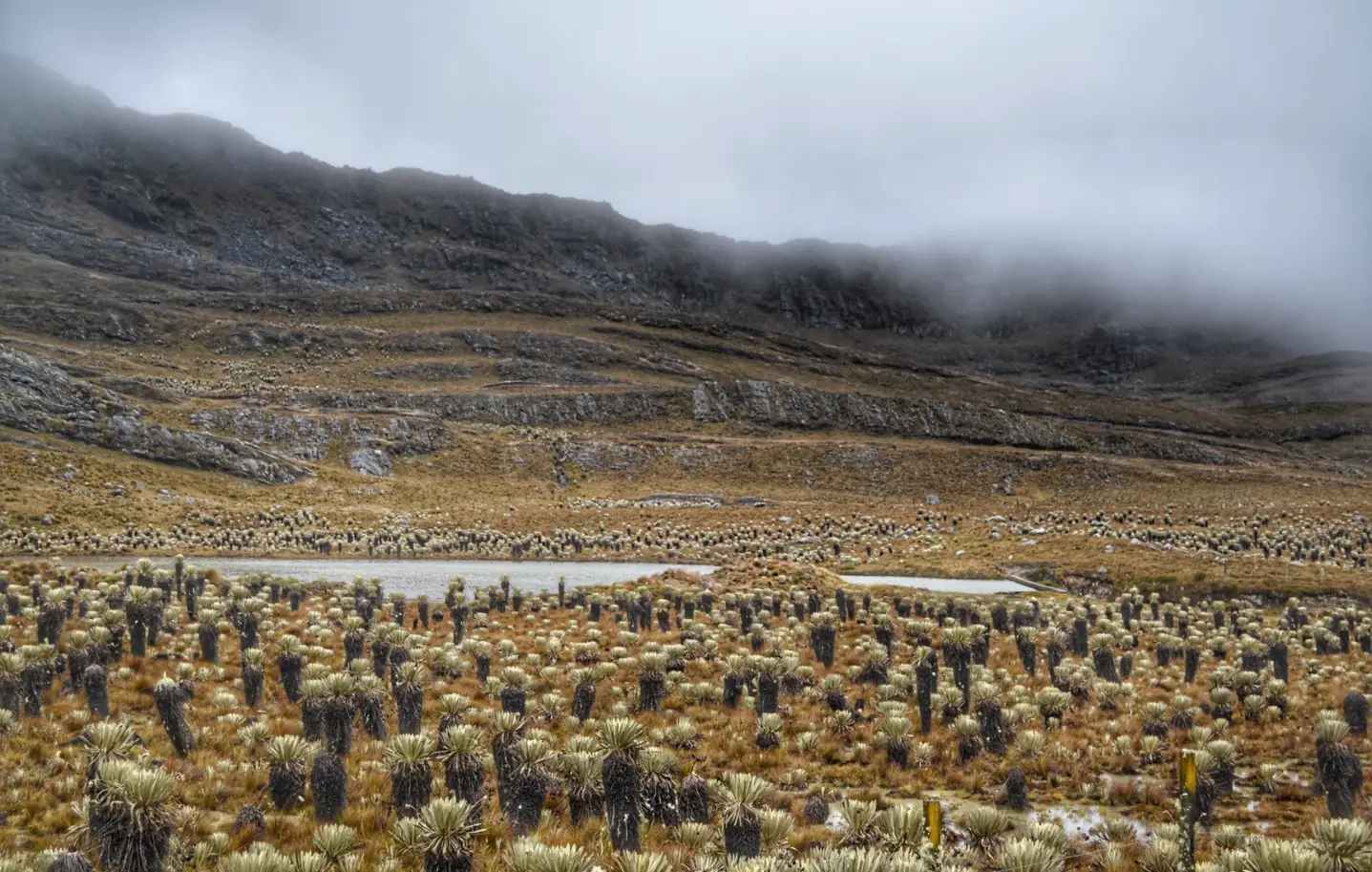This year, Colombia and Ecuador are suffering the worst water crisis in their history. In the Colombian capital, drinking water is cut off every nine days for a full day, and in Ecuador there are power cuts — generated mainly with water resources — for up to 10 hours a day. The reason is as simple as it is dramatic: water reservoirs supplying hydroelectric plants and drinking water have run dry. How have two countries in full economic growth reached such an extreme situation? Much has to do with climate change, but even more with the poor management of a fundamental natural ecosystem: the Andean páramo.
What is the Andean páramo?
The ecosystem known as páramo is found above the forest limit (generally at 3500 meters above sea level) in the Northern Andes (Venezuela, Colombia, Ecuador, and Peru) with smaller extensions in Costa Rica and Panama. At this altitude, the climate is wet and cold Under this condition, an open ecosystem has developed dominated by grasses, shrubs, a diversity of small herbs and spectacular growth forms such cushion bogs and giant rosettes, including the emblematic frailejones (“big monks”) and enormous bromeliads. This ecosystem is a habitat par excellence for the most characteristic animals of the Andes: the spectacled bear, the mountain tapir and the Andean condor. This richness and uniqueness of the flora and fauna makes the páramo the most diverse high mountain ecosystems in the world.
In total, the páramo covers around four million hectares, which corresponds to less than 5% of the surface area of the countries that comprise it. However, its economic and social importance is proportionally much bigger. The high tropical mountains, in the latitudes where the páramo is located, are usually covered with fog and received much rain. This makes the páramo humid and a large biomass of (tussock) grasses covers the soil.
Once the leaves of this layer of plants die, they are incorporated into the soil and due to the slow decomposition caused by the low temperatures, the organic matter accumulates in the soil. The dense vegetation and organic soil make the entire ecosystem behave like a sponge, retaining much of the abundant water that falls, distributing it to wetlands, streams and rivers, thus forming the basis of the water system of an important part of South America. This ecosystem service ensures the ecological balance far beyond the mountainous zone, and it is no exaggeration to say that without the páramo ecosystem, the inter-Andean valleys, the Amazon forest and the Pacific rainforest would not be as we know them.
The role of the páramo in the provision of water for the continent is not only fundamental from an ecological perspective, but also socially and economically. More than half of the population of the Northern Andes, including the entire population of Bogotá and Quito, draws water directly from the páramo, so pure that it needs almost no treatment to make it safe drinking water. In both countries, electricity generation depends largely on water originating in the high mountains. Also, the Andean agriculture of flowers and potatoes, and even the extensive rice and vegetable crops on the northern desert coast of Peru, are irrigated with water from páramos through canal systems up to more than a hundred kilometers long.
What is the cause of the water crisis in the Northern Andes?
Anomalies in rainfall patterns recently, caused by global warming and more irregular El Niño and La Niña phenomena than before, have contributed to this year being extremely dry throughout the Andean Mountain Range. This lower volume of water in the form of rain and fog in the páramo has in turn translated into less water distributed to streams, rivers, and reservoirs for drinking water and hydropower. This has led to the depletion of the water reserves in the mountains, which is causing cuts in the country’s basic public services.
But one cannot point to climate change alone; this has only accelerated the crisis. For decades, parámo ecosystem has received little attention from Andean society and their governments. Meanwhile, countless uncontrolled agricultural activities, such as poorly planned potato crops, overgrazing and associated burning of vegetation, have devastated the natural páramo vegetation and eroded its black and organic soils, damaging the natural sponge in the high mountains.
Additionally, farmers in the high Andes, marginalized by government institutions, have not been able to apply sustainable practices to their farms and have been forced to go even further up into the páramo to find more land for their crops and animals. Finally, economic investment projects such as metal mining, road construction and hydroelectric plants have contributed to the degradation of the páramo. This environmental destruction has been the real cause of parámos losing their capacity to regulate water in the Andes, and climate change is “just” one factor accelerating this crisis.
A change of course
In the last decade, after many alerts from academia and NGOs, and thanks to the uprisings of rural Andean communities in defense of territory and water and especially against mining, the problems affecting the páramo have become visible. Today, a large part of the Andean people are aware of the relationship between the páramo and access to water and that it is necessary to take care of the water towers with its natural sponges. Finally, the páramo attracts the attention of the political system and society.
Is it too late? Have we lost the battle against environmental degradation? Fortunately not. The public sector, rural communities, academia, and NGOs are investing efforts and resources to carry out sustainable management of the páramo. More than half of this ecosystem is already included in different forms of conservation, and the remaining part is under specific legislation to protect it. Now, there is compensation for farmers who decide to conserve or restore their land, and there are more and more environmentally friendly initiatives based on sustainable agriculture or ecotourism.
Although we are on the right track, we still need a pact among all sectors of society to recognize the collective and individual responsibility to strategically manage water and energy resources, to support the rural inhabitants of the high mountains to be allies in environmental management, and to give the páramo the status it deserves: a fundamental ecosystem for the future of the Andes.
*This text was produced in partnership with the Inter-American Institute for Global Change Research (IAI). The views expressed in this text are those of the authors and not necessarily those of their organizations.
Translated by Janaína Ruviaro da Silva from the original in Spanish.













